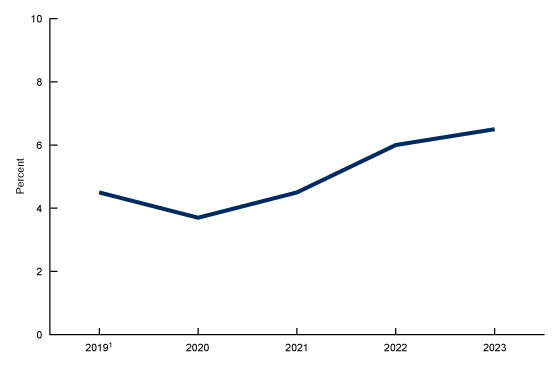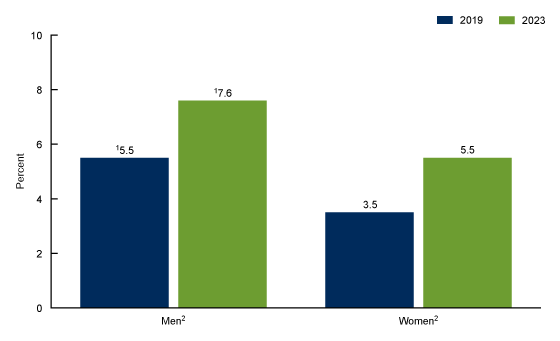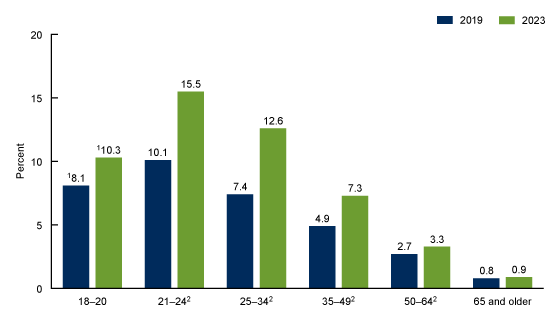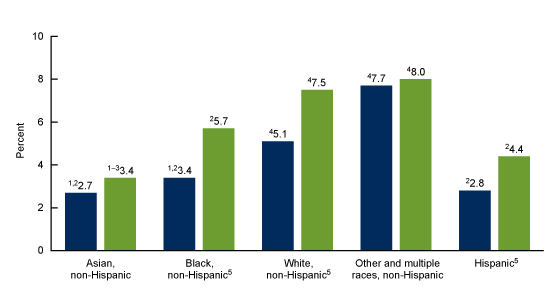Electronic Cigarette Use Among Adults in the United States, 2019–2023
NCHS Data Brief No. 524, January 2025
PDF Version (459 KB)
Anjel Vahratian, Ph.D., M.P.H., Elizabeth M. Briones, Ph.D., Ahmed Jamal, M.B.B.S., M.P.H., and Kristy L. Marynak, Ph.D., M.P.P.
Data from the National Health Interview Survey
- The percentage of adults who used electronic cigarettes increased from 4.5% in 2019 to 6.5% in 2023.
- In both 2019 and 2023, men were more likely than women to use electronic cigarettes.
- In 2023, young adults ages 21–24 were most likely to use electronic cigarettes (15.5%).
- The percentage of adults who used electronic cigarettes varied by race and ethnicity in both 2019 and 2023.
Electronic cigarettes, also known as e-cigarettes or vapes, are the most commonly used tobacco product among youth in the United States (1). Data from the 2024 National Youth Tobacco Survey showed that 5.9% of middle and high school students used electronic cigarettes in the past 30 days, a decline from 7.7% in 2023 (1). While cigarettes remain the most commonly used tobacco product among adults (2), recent trends indicate that electronic cigarette use is increasing among adults (3). This report uses data from the 2019–2023 National Health Interview Survey (NHIS) to present 5-year trends in electronic cigarette use among adults and to show how prevalence estimates changed between 2019 and 2023 for men and women and by age and race and ethnicity.
Keywords: vaping, young adult, National Health Interview Survey (NHIS)
Electronic cigarette use increased from 2020 to 2023.
The percentage of adults age 18 and older who used electronic cigarettes decreased from 2019 (4.5%) to 2020 (3.7%), then increased from 2020 to 2023 (6.5%) (Figure 1, Table 1).
Figure 1. Percentage of adults who used electronic cigarettes: United States, 2019–2023

1Significant quadratic trend by year (p < 0.05).
NOTE: Estimates are based on household interviews of a sample of the U.S. civilian noninstitutionalized population.
SOURCE: National Center for Health Statistics, National Health Interview Survey, 2019–2023.
Men were more likely than women to use electronic cigarettes.
The percentage of adults who used electronic cigarettes increased between 2019 and 2023 among both men and women (Figure 2, Table 2). Usage was higher among men compared with women in both years.
Figure 2. Percentage of adults who used electronic cigarettes, by sex: United States, 2019 and 2023

1Significantly different by sex (p < 0.05).
2Significantly different by year (p < 0.05).
NOTE: Estimates are based on household interviews of a sample of the U.S. civilian noninstitutionalized population.
SOURCE: National Center for Health Statistics, National Health Interview Survey, 2019 and 2023.
Electronic cigarette use varied by age.
Between 2019 and 2023, the percentage of adults who used electronic cigarettes increased significantly for all age groups, except those ages 18–20 and 65 and older (Figure 3, Table 3). The observed increases in prevalence for the youngest and oldest age groups was not significant.
In 2019, electronic cigarette use among adults ages 18–20 (8.1%), 21–24 (10.1%), and 25–34 (7.4%) was not significantly different; use decreased with increasing age among those 35 and older. In 2023, adults ages 21–24 (15.5%) were more likely than adults ages 18–20 (10.3%) to use electronic cigarettes. Use decreased with increasing age among those 25 and older.
Figure 3. Percentage of adults who used electronic cigarettes, by age group: United States, 2019 and 2023

1Significant quadratic trend by age (p < 0.05).
2Significantly different by year (p < 0.05).
NOTES: In 2019, all pairwise comparisons were significant (p < 0.05), except comparisons between adults ages 18–20 and 21–24 and between adults ages 18–20 and 25–34. In 2023, all pairwise comparisons were significant, except comparisons between adults ages 18–20 and 25–34. Estimates are based on household interviews of a sample of the U.S. civilian noninstitutionalized population.
SOURCE: National Center for Health Statistics, National Health Interview Survey, 2019 and 2023.
Electronic cigarette use varied by race and ethnicity.
Between 2019 and 2023, the percentage of adults who used electronic cigarettes increased significantly for Black non-Hispanic (subsequently, Black) adults, White non-Hispanic (subsequently, White) adults, and Hispanic adults (Figure 4, Table 4). The observed increase in use among Asian non-Hispanic (subsequently, Asian) adults and other and multiple-race non-Hispanic (subsequently, other and multiple-race) adults was not significant.
In 2019, other and multiple-race adults (7.7%) were more likely than Asian adults (2.7%), Hispanic adults (2.8%), and Black adults (3.4%) to use electronic cigarettes. White adults (5.1%) were more likely than Hispanic, Black, and Asian adults to use electronic cigarettes.
In 2023, other and multiple-race adults (8.0%) remained significantly more likely than Asian adults (3.4%) and Hispanic adults (4.4%) to use electronic cigarettes, and White adults (7.5%) remained significantly more likely than Hispanic, Black, and Asian adults to use electronic cigarettes.
The observed difference in prevalence between other and multiple-race and White adults in 2019 and 2023 was not significant. Both groups had the highest use in both years.
Figure 4. Percentage of adults who used electronic cigarettes, by race and ethnicity: United States, 2019 and 2023

1Significantly different from other and multiple-race non-Hispanic adults (p < 0.05).
2Significantly different from White non-Hispanic adults (p < 0.05).
3Significantly different from Black non-Hispanic adults (p < 0.05).
4Significantly different from Hispanic adults (p < 0.05).
5Significantly different by year (p < 0.05).
NOTES: Adults categorized as Hispanic may be of any race or combination of races. The category other and multiple races non-Hispanic includes those who did not identify as Asian, Black, White, or Hispanic, and those who identified as more than one race. Estimates are based on household interviews of a sample of the U.S. civilian noninstitutionalized population.
SOURCE: National Center for Health Statistics, National Health Interview Survey, 2019 and 2023.
Summary
Between 2019 and 2023, the percentage of adults who used electronic cigarettes increased from 4.5% to 6.5%. In both years, men were more likely than women to use electronic cigarettes. In 2023, young adults ages 21–24 had the highest percentage of electronic cigarette use. Other and multiple-race adults and White adults were the most likely to use electronic cigarettes in both 2019 and 2023. Significant increases over time were observed for Black, White, and Hispanic adults.
Electronic cigarettes typically contain nicotine, which is addictive and can harm brain development through about age 25 (4). While electronic cigarette use has declined among youth in recent years (1), this analysis illustrates how use has increased among adults, particularly young adults. As 1 in 10 adults ages 18–20 and about 1 in 6 adults ages 21–24 used electronic cigarettes in 2023, continued monitoring of use, particularly among young adults, is needed.
Definitions
Electronic cigarette use: Based on a yes response to the survey question, “Have you ever used an e-cigarette or other electronic vaping product, even just one time, in your entire life?” and a response of “every day” or “some days” to the survey question, “Do you now use e-cigarettes or other electronic vaping products every day, some days, or not at all?” For this analysis, narrower age groups for younger adults were selected given (a) the substantive difference in prevalence observed within subgroups of adults younger than age 49, (b) differences in brain development for those younger than age 25 (4), and (c) differences in legal access to tobacco products for those younger than age 21.
Race and ethnicity: Adults categorized as Hispanic may be of any race or combination of races. Non-Hispanic adults categorized as Asian, Black, or White indicated one race only. The category other and multiple races non-Hispanic includes those who did not identify as Asian, Black, White, or Hispanic, and those who identified as more than one race.
Data source and methods
Data from the 2019–2023 NHIS were used for this analysis. NHIS is a nationally representative household survey of the U.S. civilian noninstitutionalized population. It is conducted continuously throughout the year by the National Center for Health Statistics. Interviews are typically initiated face-to-face in respondents’ homes with follow-ups conducted by telephone as needed (5). For more information on the survey, visit the NHIS website: https://www.cdc.gov/nchs/nhis/index.htm.
Point estimates and the corresponding confidence intervals for this analysis were calculated using SAS-callable SUDAAN software (6) to account for the complex sample design of NHIS. All estimates are based on self-report and meet National Center for Health Statistics data presentation standards for proportions (7). Differences between percentages were evaluated using two-sided significance tests at the 0.05 level. Linear and quadratic trends by year and age were evaluated using orthogonal polynomials.
About the authors
Anjel Vahratian and Elizabeth M. Briones are with the National Center for Health Statistics, Division of Health Interview Statistics. Ahmed Jamal and Kristy L. Marynak are with the National Center for Chronic Disease Prevention and Health Promotion, Office on Smoking and Health.
References
- Jamal A, Park-Lee E, Birdsey J, West A, Cornelius M, Cooper MR, et al. Tobacco product use among middle and high school students—National Youth Tobacco Survey, United States, 2024. MMWR Morb Mortal Wkly Rep 73:917–24. 2024.
- Cornelius ME, Loretan CG, Jamal A, Davis Lynn BC, Mayer M, Alcantara IC, et al. Tobacco product use among adults—United States, 2021. MMWR Morb Mortal Wkly Rep 72:475–83. 2023.
- National Center for Health Statistics. Interactive summary health statistics for adults. Percentage of current electronic cigarette use for adults aged 18 and over, United States, 2019–2023. 2024.
- U.S. Department of Health and Human Services. E-cigarette use among youth and young adults: A report of the Surgeon General. 2016.
- National Center for Health Statistics. National Health Interview Survey, 2023 survey description. 2024.
- RTI International. SUDAAN (Release 11.0.3) [computer software]. 2018.
- Parker JD, Talih M, Malec DJ, Beresovsky V, Carroll M, Gonzalez JF Jr, et al. National Center for Health Statistics data presentation standards for proportions. National Center for Health Statistics. Vital Health Stat 2(175). 2017.
Suggested citation
Vahratian A, Briones EM, Jamal A, Marynak KL. Electronic cigarette use among adults in the United States, 2019–2023. NCHS Data Brief, no 524. Hyattsville, MD: National Center for Health Statistics. 2025. DOI: https://dx.doi.org/10.15620/cdc/174583.
Copyright information
All material appearing in this report is in the public domain and may be reproduced or copied without permission; citation as to source, however, is appreciated.
National Center for Health Statistics
Brian C. Moyer, Ph.D., Director
Amy M. Branum, Ph.D., Associate Director for Science
Division of Health Interview Statistics
Stephen J. Blumberg, Ph.D., Director
Anjel Vahratian, Ph.D., M.P.H., Associate Director for Science